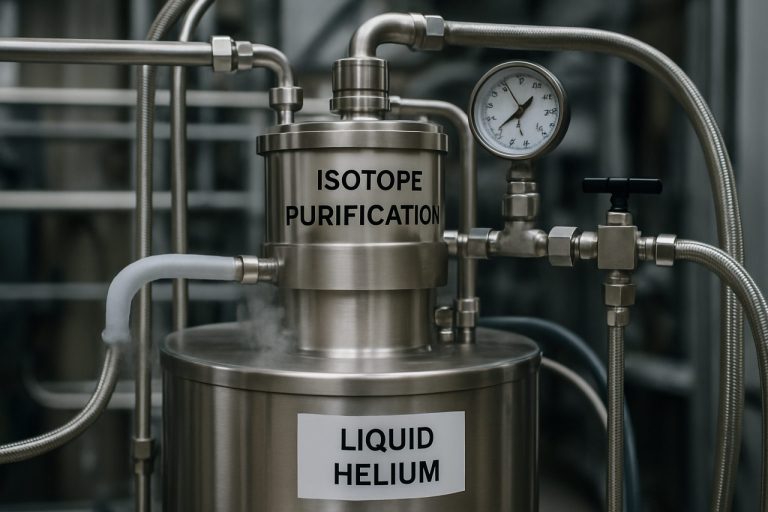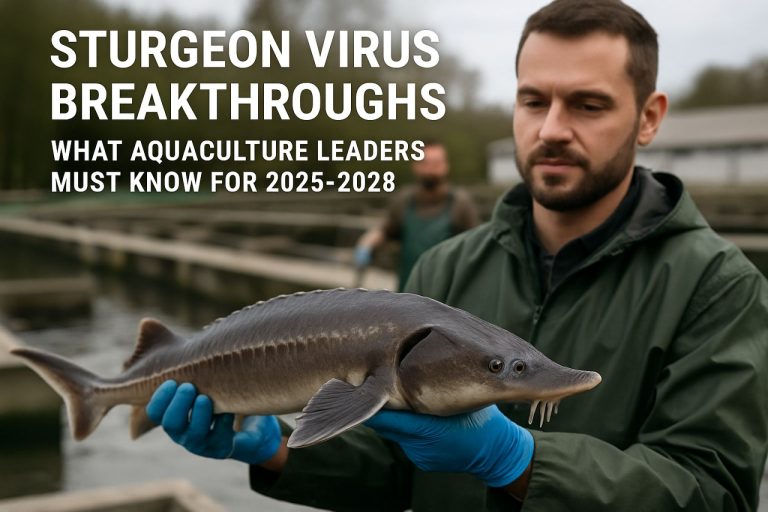
Table of Contents
- Executive Summary: Virology’s Critical Role in Juvenile Sturgeon Aquaculture
- 2025 Market Outlook: Incidence and Impact of Viral Diseases in Sturgeon Farms
- Emerging Viral Pathogens: Current Risks and New Threats on the Horizon
- Innovations in Diagnostic Technology: Real-Time Detection and Monitoring
- Case Studies: Effective Virus Management in Leading Sturgeon Hatcheries
- Regulatory and Biosecurity Trends: Global Standards for Disease Control
- Aquaculture Vaccine Development: Progress, Challenges, and Adoption Rates
- Economic Analysis: Cost of Outbreaks vs. Investment in Virology Solutions
- Forecasts to 2030: Market Growth, Technology Adoption, and Investment Trends
- Strategic Recommendations: Preparing for the Future of Sturgeon Virology (Sources: worldsturgeonsociety.com, caviarunion.org, sturgeoncentre.com)
- Sources & References
Executive Summary: Virology's Critical Role in Juvenile Sturgeon Aquaculture
Virology has emerged as a cornerstone of risk management and productivity optimization in juvenile sturgeon aquaculture as the industry enters 2025. The global expansion of sturgeon farming—driven by demand for caviar and sustainable protein—has increased the density and translocation of fish stocks, consequently elevating the risk of viral disease outbreaks, particularly among vulnerable juvenile populations. Outbreaks of sturgeon-specific viruses, such as Acipenserid herpesvirus 2 (AciHV-2) and sturgeon nucleocytoplasmic large DNA viruses (NCLDVs), have resulted in significant economic losses, often exceeding 30% mortality rates in affected hatcheries. These events underscore the necessity of robust viral surveillance, biosecurity, and rapid diagnostic practices, which are now seen as indispensable to commercial viability.
In 2025, industry leaders and research organizations are increasingly collaborating on early detection and containment strategies. The adoption of advanced molecular diagnostics—including real-time PCR assays and portable sequencing technologies—has accelerated, enabling producers to identify pathogens before clinical signs manifest. Companies such as Bionorica and QIAGEN have developed diagnostic kits tailored to aquatic pathogens, including those affecting sturgeon. Moreover, the use of environmental DNA (eDNA) surveillance is gaining traction, allowing for the non-invasive monitoring of viral presence in recirculating aquaculture systems (RAS), as promoted by organizations like Eurofins.
Vaccination against sturgeon viruses remains in experimental phases, with commercial solutions not yet widely available. However, government and academic laboratories are prioritizing vaccine development, recognizing its potential for long-term disease mitigation. Meanwhile, hatcheries are focusing on optimized biosecurity protocols, drawing on best practices from industry bodies such as the American Fisheries Society and the European Food Safety Authority, which emphasize strict water quality management, stock separation, and disinfection routines.
Looking ahead to the next few years, the outlook for virology in juvenile sturgeon aquaculture is defined by the convergence of technological innovation and regulatory oversight. Automation in monitoring and data collection is anticipated to further reduce outbreak response times. At the same time, regulatory frameworks are expected to evolve, with agencies such as the World Organisation for Animal Health (WOAH) updating notifiable disease lists and reporting protocols specific to sturgeon pathogens. These advancements position virology as a linchpin for sustainable growth, enhanced animal welfare, and the continued expansion of the sturgeon aquaculture sector worldwide.
2025 Market Outlook: Incidence and Impact of Viral Diseases in Sturgeon Farms
The outlook for juvenile sturgeon aquaculture virology in 2025 reflects both persistent challenges and emerging responses to viral disease threats. As global demand for sturgeon products—particularly caviar—continues to grow, the intensive culture of juvenile sturgeon increases the risk of viral outbreaks, with significant implications for farm productivity and biosecurity.
Among the most consequential viral pathogens affecting juvenile sturgeon in aquaculture are sturgeon nucleocytoplasmic large DNA viruses (NCLDVs), particularly those related to the Iridoviridae family, as well as sturgeon herpesviruses. These viruses have been implicated in episodic mortality events and suboptimal growth, particularly in young fish under intensive rearing conditions. Outbreaks can result in high morbidity and mortality rates, sometimes exceeding 50% among susceptible cohorts, leading to substantial economic losses for producers.
Recent data from sturgeon-producing regions in Eastern Europe and Asia—where aquaculture of juvenile sturgeon is concentrated—indicate that viral disease incidence remains a pressing concern. For example, European Aquaculture Society industry reports in 2024 noted an uptick in reported cases of viral infections, particularly in facilities with high stocking densities or lapses in water quality management. Similarly, biosecurity surveys coordinated by the Food and Agriculture Organization have highlighted the continued risk posed by unregulated movement of broodstock and juveniles between farms, facilitating pathogen spread.
In response, industry stakeholders are intensifying disease monitoring and investing in diagnostic infrastructure. For instance, specialist suppliers such as bioMérieux and IDEXX Laboratories have expanded their aquaculture-focused virology diagnostics portfolios, making routine screening for sturgeon-specific viruses more accessible to farms in 2025. Adoption of real-time PCR and next-generation sequencing is expected to improve early detection and containment of emerging viral threats.
Looking ahead, the regulatory and commercial landscape is likely to see increased emphasis on certified disease-free stock and traceability. Initiatives by organizations such as the World Sturgeon Conservation Society are promoting the adoption of standardized health protocols and international guidelines for sturgeon movement. Additionally, there is mounting interest in selective breeding for viral resistance, though practical implementation is still in early stages.
Overall, the outlook for 2025 and the subsequent years indicates that while viral diseases remain an acute risk for juvenile sturgeon aquaculture, coordinated biosecurity, technological advancements in diagnostics, and evolving best practices are set to mitigate their impact and support industry sustainability.
Emerging Viral Pathogens: Current Risks and New Threats on the Horizon
In 2025, the virological landscape of juvenile sturgeon aquaculture is characterized by both persistent and emerging threats, with significant implications for farm productivity and conservation of endangered species. Several well-documented viruses—including Acipenser iridovirus European (AcIV-E), white sturgeon iridovirus (WSIV), and sturgeon herpesviruses—remain primary concerns for hatcheries and grow-out farms worldwide. Outbreaks of AcIV-E, first recognized in European facilities, have spread to North America and Asia, causing substantial morbidity and mortality in juvenile sturgeons. Recent surveillance data indicate that AcIV-E continues to circulate in recirculating aquaculture systems (RAS), with sporadic outbreaks tied to vertical and horizontal transmission routes (European Union Reference Laboratory for Fish Diseases).
Concurrently, new threats are emerging. In late 2024 and early 2025, molecular diagnostic advances enabled detection of novel iridoviruses and herpesviruses in juvenile sturgeon stocks, particularly in Russia and Eastern Europe, regions that supply a significant proportion of global seedstock. These discoveries have prompted regional biosecurity alerts and collaborative risk assessments among producers and regulatory authorities (Caviar Union). The genetic diversity of these new viral strains raises concerns about cross-species transmission and the efficacy of current disease management protocols.
The industry response has focused on enhanced surveillance, pathogen screening, and investment in RAS-based production, which offers better biosecurity than traditional pond or flow-through systems. Leading hatchery equipment suppliers have reported increased demand for integrated UV and ozone water treatment solutions, which are shown to reduce viral loads in hatcheries (AquaMaof Aquaculture Technologies). International caviar producers are cooperating on data sharing and standardization of viral screening as part of their quality assurance and sustainability certifications (Beluga Sturgeon Company).
Looking ahead, the outlook for 2025 and beyond is shaped by both technological innovation and regulatory harmonization. There is a strong push for the development of rapid, on-site molecular diagnostics and for research into potential antivirals or vaccines targeted at the most severe pathogens. However, the high genetic variability of sturgeon viruses remains a challenge for vaccine design. The sector is also bracing for possible climate-driven shifts in pathogen ecology, which could alter the prevalence and distribution of both established and novel viruses. Industry and government partnerships are expected to intensify, with a focus on harmonized import/export health standards and coordinated outbreak response protocols (European Food Safety Authority).
Innovations in Diagnostic Technology: Real-Time Detection and Monitoring
The aquaculture industry’s growing focus on juvenile sturgeon health has accelerated the adoption of innovative diagnostic technologies, particularly in virology. In 2025, rapid and real-time detection methods are becoming standard practice in many commercial hatcheries and research facilities, aiming to address the persistent challenge of viral pathogens such as sturgeon nucleocytoplasmic large DNA viruses (sNCLDVs) and iridoviruses.
Key advances include the deployment of portable, field-deployable PCR systems and isothermal amplification platforms. These technologies offer on-site, real-time viral detection with high sensitivity and specificity, enabling hatchery managers to implement immediate biosecurity measures. For instance, companies like QIAGEN and Thermo Fisher Scientific have made significant strides in delivering PCR-based solutions tailored for aquaculture environments, allowing for the early identification of viral outbreaks in juvenile sturgeon populations.
Emerging in 2025 are also digital PCR platforms and biosensor-based assays, which offer quantification and multiplex pathogen detection within a single workflow. The use of lateral flow assays and microfluidic chips, from suppliers like Merck KGaA, is facilitating routine surveillance with minimal technical training. These innovations are particularly suited for sturgeon hatcheries, where rapid decision-making is critical to prevent the spread of viruses that can cause significant mortality events.
Real-time monitoring is further enhanced by integration with data management systems. Cloud-connected diagnostic devices enable continuous tracking and remote alerting, providing a comprehensive view of viral prevalence over time. Some facilities are piloting automated water sampling and analysis units, which use real-time RT-PCR to monitor waterborne viral loads, a strategy supported by system manufacturers such as Eppendorf.
Looking ahead, the next few years will likely see the refinement of point-of-care virology diagnostics for sturgeon aquaculture, including AI-driven interpretation of test results and expanded pathogen panels. The steady reduction in equipment costs and increased user-friendliness are set to make these technologies accessible to a broader range of hatcheries, including smaller operations. Industry bodies such as the Food and Agriculture Organization of the United Nations (FAO) are emphasizing the importance of these innovations for sustainable sturgeon production and international trade compliance.
Overall, real-time diagnostic and monitoring technologies are reshaping juvenile sturgeon aquaculture virology in 2025, providing actionable insights that protect stock health and ensure the viability of this valuable industry.
Case Studies: Effective Virus Management in Leading Sturgeon Hatcheries
The management of viral diseases in juvenile sturgeon aquaculture remains a critical focus for hatcheries worldwide, especially as the global demand for caviar and sturgeon products continues to rise. In 2025, several leading hatcheries and aquaculture firms have reported significant advancements in virus management protocols, leveraging both traditional and innovative approaches to safeguard their stocks.
One notable case study comes from Beluga Sturgeon Farm in Belarus, which has implemented a multi-tiered biosecurity program targeting the prevention and early detection of sturgeon herpesvirus (Acipenserid herpesvirus 2, AciHV-2). Their strategy includes strict water quality monitoring, rigorous quarantine procedures for newly acquired broodstock, and the integration of real-time PCR diagnostics. As a result, the farm reported a 40% reduction in juvenile mortality linked to viral outbreaks between 2023 and 2024, a trend they project to continue through 2025.
In Italy, Italian Sturgeon Company has collaborated with veterinary virologists to develop an early warning system for viral hemorrhagic septicemia (VHS) and infectious pancreatic necrosis (IPN). By combining environmental DNA (eDNA) screening with routine health assessments, the hatchery has been able to detect viral presence before the onset of clinical symptoms in juveniles. This preemptive management has enabled rapid isolation of affected tanks and prevented large-scale outbreaks, maintaining survival rates above 90% in their 2024 and early 2025 cohorts.
Another example is the Russian Caviar House, which has pioneered the use of immunostimulant feed additives and probiotics to enhance the innate resistance of juvenile sturgeon to viral infections. Since incorporating these dietary supplements in late 2022, the hatchery has noted a consistent decrease in the incidence of both known and emerging viral pathogens, with internal data suggesting a 30% improvement in overall juvenile health indices.
Looking ahead to the next few years, these case studies indicate a clear trend towards integrated virological management, combining advanced diagnostics, biosecurity, and immunoprophylaxis. Industry bodies such as the European Fish Biosecurity Network are actively promoting knowledge exchange and harmonized protocols, aiming to reduce the risk of transboundary viral spread as sturgeon aquaculture expands. The focus for 2025 and beyond will likely center on real-time surveillance, rapid diagnostics, and tailored health management plans, ensuring sustainable production and reduced losses in juvenile sturgeon populations.
Regulatory and Biosecurity Trends: Global Standards for Disease Control
Global regulation and biosecurity practices in juvenile sturgeon aquaculture virology are evolving rapidly in 2025, reflecting increased concern over the spread of viral pathogens such as Acipenser iridovirus European (AcIV-E) and sturgeon nucleocytoplasmic large DNA viruses (NCLDVs). The sector is witnessing harmonization efforts across regions, driven by the need to protect both farmed and wild sturgeon populations, many of which are endangered.
The World Organisation for Animal Health (WOAH) continues to update and expand its Aquatic Animal Health Code, with specific guidelines for surveillance, reporting, and control of sturgeon-specific viral pathogens. In 2025, WOAH’s recommended standards for viral pathogen screening in live animal movements, particularly international trade of fertilized eggs and juveniles, have become widely adopted by national authorities. This includes mandatory health certification and implementation of quarantine protocols.
The European Union, through the European Commission Directorate-General for Health and Food Safety, enforces the EU Animal Health Law (Regulation (EU) 2016/429) which has, as of 2025, been updated to include explicit mention of sturgeon-relevant viral diseases. This mandates all hatcheries and juvenile sturgeon producers in member states to implement regular diagnostic screening and maintain detailed records of health status, with non-compliance resulting in restricted movement or trade bans.
- In China—the world’s largest sturgeon producer—biosecurity standards have been revised by the Ministry of Agriculture and Rural Affairs in line with international guidelines, focusing on enhanced viral surveillance, disinfection protocols, and genetic traceability of stock to prevent cross-farm contamination.
- North America, led by the U.S. Fish and Wildlife Service Aquatic Animal Drug Approval Partnership, has prioritized the inclusion of sturgeon-specific pathogens in the National Aquatic Animal Health Plan. New requirements for diagnostic laboratory accreditation and reporting of notifiable viral diseases have been enacted.
Looking ahead, technological advances in rapid molecular diagnostics and digital health certification are expected to further streamline compliance and early pathogen detection. Companies like IDEXX Laboratories and QIAGEN are developing PCR-based test kits tailored for sturgeon virology, likely to become standard tools in hatcheries over the next few years. The global trend is toward greater transparency, traceability, and harmonization of biosecurity protocols, with a strong outlook for collaborative international surveillance networks to mitigate viral disease risks in juvenile sturgeon aquaculture.
Aquaculture Vaccine Development: Progress, Challenges, and Adoption Rates
In 2025, the aquaculture sector faces both significant opportunities and ongoing challenges in managing viral diseases affecting juvenile sturgeon, a high-value group in global caviar and meat production. Viral infections, notably sturgeon nucleocytoplasmic large DNA viruses (sNCLDVs) such as white sturgeon iridovirus (WSIV) and mimivirus-like agents, continue to threaten sturgeon health, particularly in intensive juvenile rearing systems. Recent years have witnessed increased attention from both scientific and commercial entities toward vaccine development, yet the path to widespread adoption and practical deployment remains complex.
Advancements in molecular diagnostics have improved early detection and characterization of sturgeon viruses, supporting targeted vaccine design. For instance, companies such as Phibro Aqua and Merck Animal Health have expanded their research portfolios to address emerging fish viruses, including those affecting sturgeon, by leveraging next-generation sequencing and antigen discovery platforms. Although no commercial vaccines are currently licensed specifically for sturgeon virology as of early 2025, several prototypes are under experimental evaluation, focusing on inactivated and subunit vaccine candidates targeting WSIV and related pathogens.
Field trials in Europe, North America, and China—regions with major sturgeon aquaculture—are ongoing in partnership with large fish health companies and sturgeon producers (e.g., AquaGroup and Belarusian State Association Belryba). These collaborations aim to assess vaccine safety, immunogenicity, and effectiveness in reducing mortality and viral shedding during critical juvenile stages. Early data from these trials suggest promise for reducing disease incidence, yet optimal vaccination timing, delivery methods, and long-term immunity require further refinement.
Industry adoption rates of aquaculture vaccines, even for other species, are influenced by cost-benefit analyses, regulatory pathways, and producer education. As noted by Fish Veterinary Society, uptake among sturgeon producers will likely follow trends observed in more established finfish sectors, where vaccine adoption accelerates after demonstration of tangible economic and stock health benefits. However, sturgeon’s relatively slow growth and long production cycles render return-on-investment calculations more complex.
Looking ahead, the next few years are poised for incremental progress rather than rapid transformation. Key developments will include regulatory submissions for novel sturgeon vaccines, refinement of delivery technologies (such as immersion and oral vaccination), and integration of vaccination with broader biosecurity programs. Engagement between vaccine developers, producers, and regulatory authorities will be crucial for translating promising laboratory results into field-ready solutions, with the goal of safeguarding juvenile sturgeon health and supporting the sector’s sustainable growth.
Economic Analysis: Cost of Outbreaks vs. Investment in Virology Solutions
The economic landscape of juvenile sturgeon aquaculture is increasingly shaped by the risks and realities of viral outbreaks. In 2025, the sector faces significant financial threats from diseases such as sturgeon iridovirus and herpesvirus, which can decimate stocks and undermine long-term profitability. Outbreaks in juvenile populations are particularly costly due to the high value of sturgeon caviar and meat, and the extended grow-out periods required before harvest. Direct costs of an outbreak typically include mortality losses, emergency treatments, and disruption of production cycles. Indirect costs—such as reputational damage, lost market share, and delayed stocking—can be equally substantial.
Recent figures from European and North American sturgeon producers indicate that a single large-scale outbreak in a mid-sized facility can result in losses exceeding several million euros or dollars, depending on the extent of infection and the value of affected juveniles. For instance, data released by Aqualma and Caviar House & Prunier highlight how outbreaks of viral diseases in recent years have led to up to 40% mortality in some cohorts, forcing emergency culling and resulting in the loss of two to three years’ worth of investment per affected batch. Moreover, the cost of implementing biosecurity measures post-outbreak, such as facility upgrades and enhanced testing, can add hundreds of thousands of euros to operational budgets.
On the other hand, proactive investment in advanced virology solutions—such as regular PCR-based screening, on-site diagnostic labs, staff training, and the adoption of closed recirculating aquaculture systems (RAS)—has shown to dramatically lower both the frequency and severity of outbreaks. Companies like Sturgeon Center and Bester Caviar have reported that annual expenditures on comprehensive virology and biosecurity protocols typically range from €100,000 to €250,000 for mid-sized operations, a fraction of the losses incurred from a single major outbreak.
Looking forward, industry bodies such as Federation of European Aquaculture Producers (FEAP) anticipate that the widespread adoption of molecular diagnostics and real-time monitoring will become standard practice by 2027, further reducing economic risks. The return on investment in virology solutions is expected to improve as technology costs decrease and regulatory incentives for disease-free certification strengthen market access. In summary, the sector’s economic outlook in 2025 and beyond increasingly favors preventative investment in virology over reactive spending in the wake of outbreaks, with mounting empirical evidence supporting this strategic shift.
Forecasts to 2030: Market Growth, Technology Adoption, and Investment Trends
The global expansion of sturgeon aquaculture, particularly for caviar production, is set to continue through 2030, intensifying the industry’s focus on juvenile sturgeon health and virology. As production scales up in Europe, North America, and Asia, the sector faces both opportunities and challenges tied to viral disease management in juvenile stocks. The most significant threats include sturgeon iridovirus, herpesvirus, and other emerging pathogens impacting fry and fingerlings, with outbreaks leading to substantial economic losses and regulatory scrutiny.
Between 2025 and 2030, market growth is projected to be underpinned by increasing consumer demand for sustainably farmed caviar and sturgeon meat, particularly in China and the European Union. Industry leaders such as Beluga Group (Belarus), Russian Caviar House, and Sturgeon Aquafarms (USA) are investing heavily in advanced biosecurity, virology diagnostics, and vaccination protocols to safeguard juvenile stocks. These investments aim to minimize losses from viral outbreaks, which, according to Food and Agriculture Organization of the United Nations (FAO) data, have accounted for up to 20% reductions in juvenile survival rates during significant incidents.
Technological adoption over the forecast period is expected to focus on several fronts:
- Real-time Virology Monitoring: Automated water quality and pathogen monitoring systems are being piloted by companies like Xylem Inc. and Pentair, integrating molecular diagnostic tools for early viral detection in hatchery environments.
- Genetic Selection: Breeding programs are increasingly incorporating genomic tools to enhance resistance in juvenile stocks, as demonstrated by ALSEA Sturgeon and their collaborations with academic partners.
- Vaccination and Prophylactics: Research and development into effective vaccines for major sturgeon viruses are underway, with companies such as Phibro Animal Health Corporation exploring novel immunization strategies.
Investment trends indicate a surge of capital flowing into RAS (recirculating aquaculture systems) and biosecure hatchery infrastructure, with direct implications for improved virology control. The shift is supported by public funding initiatives and private equity, as outlined in strategic plans from organizations like EUROFISH International Organisation.
By 2030, experts anticipate that virology management in juvenile sturgeon aquaculture will be defined by rapid diagnostic deployment, genetic resistance, and integrated health protocols. These advancements promise to reduce mortality rates, enhance production yields, and ensure market stability, supporting the continued growth of the sturgeon aquaculture sector worldwide.
Strategic Recommendations: Preparing for the Future of Sturgeon Virology (Sources: worldsturgeonsociety.com, caviarunion.org, sturgeoncentre.com)
The evolving landscape of juvenile sturgeon aquaculture virology in 2025 necessitates a proactive and multifaceted strategic approach. As viral pathogens continue to pose significant threats to sturgeon health and farm productivity, industry stakeholders must prioritize both immediate and long-term measures to safeguard stock and ensure economic viability. Drawing on industry expertise and developments from recognized bodies, the following strategic recommendations are poised to help operations future-proof their virological management.
- Enhanced Surveillance and Early Detection: The continued emergence of viral diseases, such as sturgeon nucleocytoplasmic large DNA viruses (NCLDVs), underscores the need for robust diagnostic infrastructure. Farms are encouraged to implement regular, sensitive screening protocols for early identification of viral pathogens, leveraging molecular diagnostics recommended by organizations such as the World Sturgeon Conservation Society. Early detection is critical for containment and reducing wider farm losses.
- Biosecurity Intensification: As trade and movement of live sturgeon juveniles increase, so too does the risk of viral transmission. Strategic investment in quarantine facilities, disinfection routines, and water treatment systems is advised. The International Caviar Producers Union advocates for the standardization of biosecurity protocols across facilities, citing recent cross-border outbreaks and the need for collective risk mitigation.
- Genetic and Breeding Programs: Selective breeding for disease resistance is emerging as a promising long-term strategy. Institutions such as the Sturgeon Centre are developing genetic lines with enhanced resilience to specific viral agents. Collaboration with such breeding programs can enable farms to gradually reduce the impact of endemic viruses.
- Vaccination and Immunostimulation Research: While sturgeon-specific commercial vaccines are still under development, ongoing research into immunostimulants and prototype vaccines holds potential. Farms should stay informed about these advances, participate in pilot studies when feasible, and prepare for eventual adoption of immunoprophylactic measures.
- Continuous Education and Stakeholder Engagement: Training farm personnel in virology best practices and fostering a culture of vigilance are essential. Regular knowledge exchange through workshops and networks sponsored by the World Sturgeon Conservation Society and industry partners ensures that operators remain updated on emerging threats and control innovations.
Looking ahead, the integration of these strategies will be instrumental for sturgeon aquaculture operators navigating the evolving virological challenges of 2025 and beyond. By investing in surveillance, biosecurity, genetics, and education, the sector can enhance resilience and secure the sustainable growth of juvenile sturgeon production.
Sources & References
- Bionorica
- QIAGEN
- European Food Safety Authority
- Food and Agriculture Organization
- bioMérieux
- IDEXX Laboratories
- European Union Reference Laboratory for Fish Diseases
- Thermo Fisher Scientific
- Eppendorf
- European Commission Directorate-General for Health and Food Safety
- U.S. Fish and Wildlife Service Aquatic Animal Drug Approval Partnership
- Merck Animal Health
- Fish Veterinary Society
- Federation of European Aquaculture Producers (FEAP)
- Pentair
- EUROFISH International Organisation



